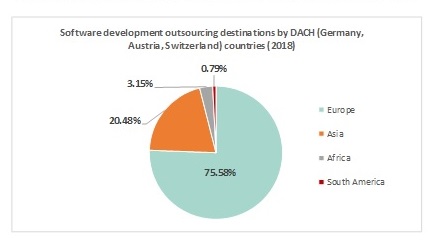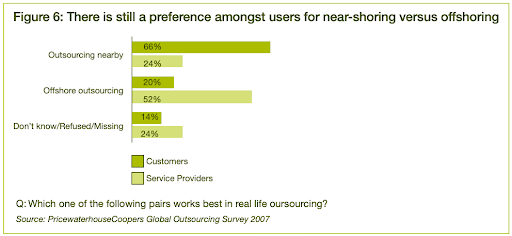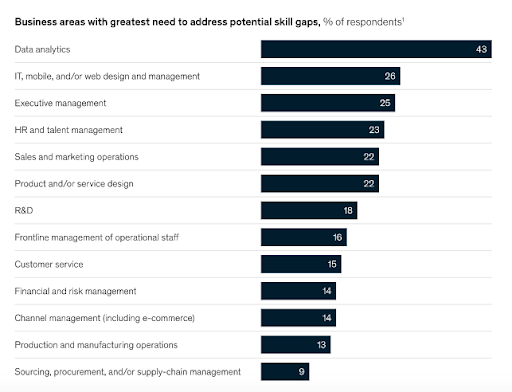It’s official: More organizations than ever are nearshoring their software development needs.
Check the numbers out. An impressive 67% of Dutch companies and 75.58% of companies in the DACH region (Germany, Austria, Switzerland) outsource software development within Europe. Similarly, a growing number of businesses in the U.S. are seeking outsourcing partners in Latin America.

What are the reasons for the spike in popularity of nearshore software outsourcing, and is it a good fit for your business?
Read on to find out!
What Is Nearshoring?
Nearshore Software Development Definition:
Nearshoring is a software development model where you outsource specific tasks, services, or entire projects to a vendor in a nearby country. This is similar to but different from offshoring, which involves contracting services to a provider based on another continent.
Common nearshore outsourcing examples would be, for instance, a German company partnering with extended development teams in Spain or Poland, or a U.S. customer delegating work to a nearshore company in South or Central America.
What Are the Advantages of Nearshoring?
Outsourcing customers already showed a clear preference for nearshoring as far back as 2007.

And no wonder — nearshoring has significant advantages over both offshore and in-house development. Key benefits of nearshoring include:
Geographical Proximity
Perhaps the greatest advantage of nearshoring software development is the geographical proximity of the outsourcing partners. The time zone differences, if any, are rarely more than one to three hours. This enables faster communication, allows in-house and remote teams to collaborate more closely, and gives you a higher level of control over the development process than offshore arrangements.
With your nearshoring partner just a short flight away, it’s also fairly easy to have live meetings when in-person communication is required. Plus, the travel costs shouldn’t be too prohibitive.
Better Cultural Fit
There’s more to effective communication than a good command of the English language. Cultural differences, societal norms, and nonverbal cues also come into play — which means that remote teams based in distant countries are more likely to experience linguistic and cultural barriers.
In contrast, the closer proximity of nearshore vendors ensures a better organizational fit and helps keep misunderstandings to a minimum. Customers in Western Europe and North America working with outsourcing partners based in Europe or Latin America, respectively, can expect a work ethic and organizational culture similar to that of their in-house employees.
Significant Time Saving
Setting up a nearshore team is usually more time-effective than an in-house one, and not at the expense of experience, credentials, or expertise. While offshoring can be even cheaper in terms of developer rates, nearshoring often comes with additional savings associated with better and faster communication, a shorter time-to-market and improved quality control.
Consider, for instance, the minimum notice periods for termination of employment. Periods of three months or more are the norm in Germany. In contrast, the minimum statutory notice is one month in Portugal and a mere 15 days in Spain. What’s more, developers from the EU don’t need visas or permits to work with EU-based customers, unlike developers based in third countries.
As a result, it’s often easier and quicker to get a nearshore arrangement up and running than to set up an in-house development team.
A Larger Talent Pool
Skilled labor is always in high demand, and the IT industry is no different. In the U.S. alone, the Bureau of Labor Statistics expects software developer employment to grow by 22% between 2020 and 2030, compared to an 8% average projected growth for all occupations.
But you don’t need to wait until 2030 to know where the market is going. Back in 2020, McKinsey reported that 26% of employers were already struggling to fill IT skill gaps, and a 2018 LinkedIn study found that turnover in the tech sector stood at 13.2%, the highest of any industry.

The competition for attracting and retaining talented developers is fierce, especially when it comes to senior-level positions. Here’s where nearshore outsourcing comes in. This business model enables you to transcend the limitations of your domestic market and find world-class engineers abroad, often at more competitive rates, and without the hassle of traditional offshoring.
Case Studies: 2 Real-Life Nearshoring Examples
The best way to learn how nearshore project management works is to examine real-life examples of successful software development outsourcing. Here are three case studies from our practice at Zartis:
Nearshoring Example #1: Dropp
Project Type: Initial Product Development from Scratch
Dropp is a startup offering fast, convenient, and sustainable last-mile delivery services for ecommerce businesses. The company sought to create a technical strategy that would maximize scalability and security, utilize best software development practices, and enable their product to hit the market as quickly as possible.
The Nearshore Team
We rolled out a nearshore solution for our clients at Dropp in two phases.
In the first phase, we focused on delineating a technical strategy. We deployed a consulting team of experts in software architecture, infrastructure, continuous integration/continuous delivery (CI/CD) processes, and quality assurance (QA). Our technology consultants worked closely with Dropp’s leadership to understand their current technologies and align the proposed strategy with their business goals.
Based on our analysis, we devised a technical strategy that featured:
- Recommendations on what to buy and what to build
- Tech stack recommendations
- A detailed roadmap for carrying out the strategy
- A plan for ensuring resilient architecture and infrastructure
Then, in the second phase of the project, we assembled a dedicated nearshore team of engineers specializing in the chosen tech stack (React, Typescript, Node.js) to deliver on the strategy we had devised.
Nearshoring Benefits
- Tech stack definition: Our team helped Dropp define the technologies to be used in their product in the long term.
- Technical strategy: In consultation with the in-house team, we devised a technical strategy and timeline to help Dropp achieve product launch for go-to-market.
- Software architecture: We helped in the design of the software architecture and the wider system.
- Quality assurance: To ensure delivery and on-going success, our developers continue to work with the Dropp team on an ongoing basis.
Nearshoring Example #2: Fexco
Project Type: Integrating a Nearshore Team with the Client’s In-House Workforce
Fexco is a global fintech and business services provider based in Ireland. In 2016, Fexco sought to modernize its tech stack and replace some of its on-premise legacy software with cloud-based solutions. However, the company was struggling to find high-skilled talent locally.
The Nearshore Team
We quickly set up a team of 11 full-stack developers based in Spain and Poland. They got to work and migrated one of Fexco’s on-premise applications to a new cloud solution using Microsoft Azure and microservices architecture.
Next, the nearshore team helped Fexco’s in-house engineers create a central API by specifying the delivery lifecycle and quality controls and introducing a new architecture and tech stack. Our developers then leveraged the central API to rewrite another on-premise application and migrate it to the cloud.
Our collaboration with Fexco is ongoing and currently has the nearshore and in-house teams working together on various Fintech projects.
Nearshoring Benefits
- Replacing legacy software with modern cloud applications
- New, modern tech stack
- Knowledge exchange between the in-house and nearshore team
- High return on investment
For more details on our work with Fexco, see here.
Looking for a Nearshore Software Development Company You Can Trust?
You’ve come to the right place. At Zartis, nearshore agile software development is our bread and butter.
We’ll set up a stellar nearshore team for you in no time. We take care of all the details so that you can focus on the larger picture — growing your business and delighting your customers.
Zartis has been selected among the Top 15 Custom Software Development Companies in the United Kingdom. Learn more about our nearshoring services, or contact us directly to tell us about your needs.

